Analysis of the Hydrodynamics Behavior Inside a Stirred Reactor for Lead Recycling
Abstract
:1. Introduction
2. Mixing Analysis
3. Geometrical Description of the Tank and Stirrer
4. Initial Assumptions
- (a)
- The influence of the shaft is not significant because it is placed in the middle of the reactor to achieve symmetrical conditions, and no vibration is assumed during rotation. Thus, the shaft is a rotatory wall in the middle of the tank without influence over the fluid dynamics;
- (b)
- The reactor walls are free of defects; as a consequence, there is no friction or drag effect; nevertheless, the path of the fluid and speed vectors can be modified due to the liquid particles impacting the walls at different angles;
- (c)
- The impeller rotatory speed is constant during the simulation. It is constant at 200 radians per minute. The impeller is submerged inside the reactor at a central position;
- (d)
- The surface of the liquid lead is flat; this means that no turbulence condition is assumed over the surface or that the tank is a closed volume;
- (e)
- The lead temperature of the liquid lead is assumed at 327 °C during the simulation, and the system is assumed as isothermal;
- (f)
- The tracer is injected in only one injection point at the start time (t = 0) for each simulation case. Thus, the tracer’s concentration at all monitoring points is equal to zero (Cm1 = Cm2, … Cm15 = 0). Moreover, the resident liquid is only lead with constant properties, and the tracer is also assumed to have the same properties as lead;
- (g)
- The velocity vectors at the beginning of the simulation are shown in Figure 4a,b, all around the tank and near the blades of the impeller, respectively. Then, a certain volume of lead is replaced with the tracer, which has the same properties as lead. Then, the fluid is assumed to be homogeneous (there are no inclusions or other fluids involved).
- (h)
- Simulations are conducted individually to analyze the hydrodynamics behavior and efficiency of the tracer’s distribution at every injection point.
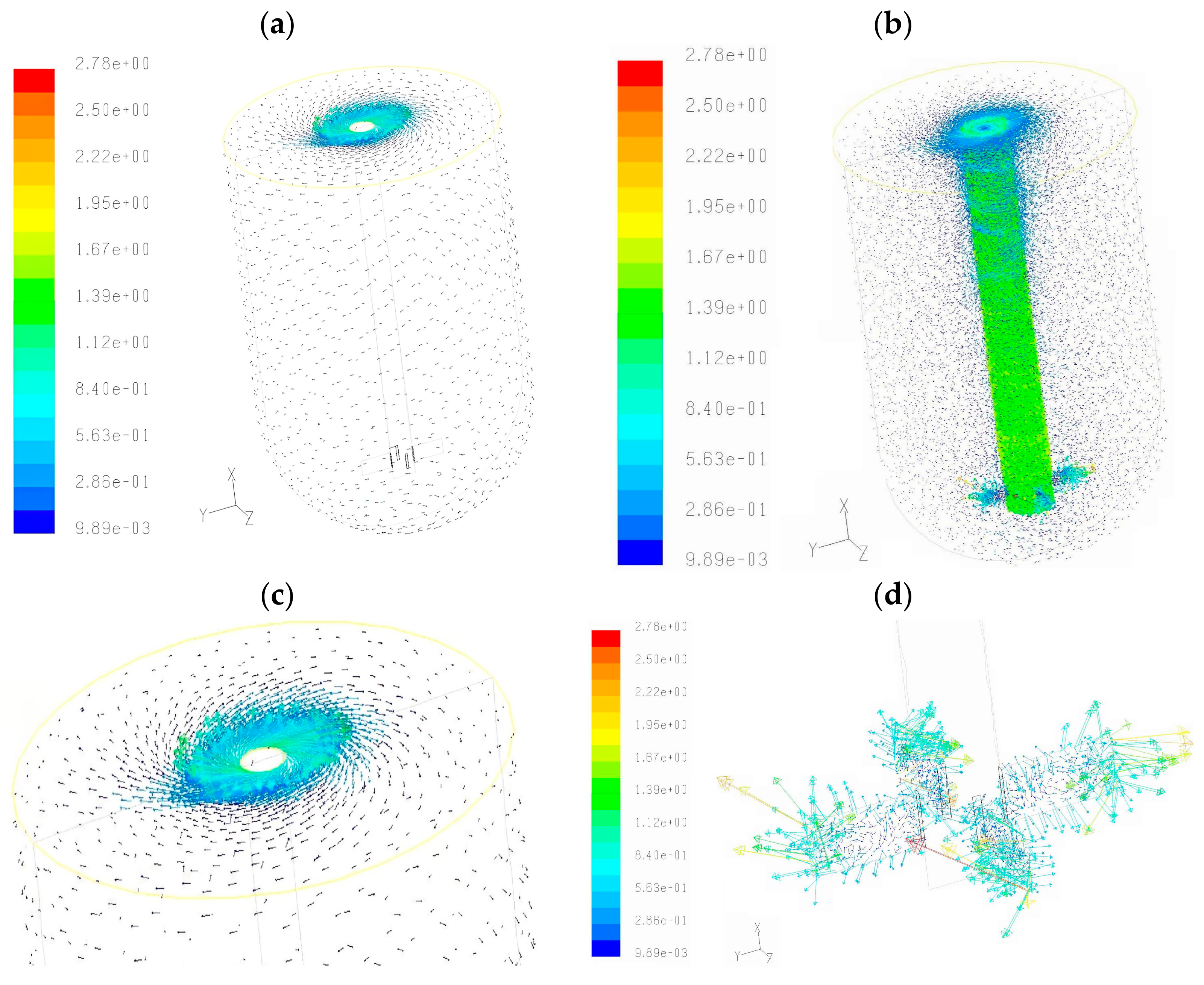
5. Mathematical Model
6. Analysis and Efficiency of Mixing
7. Validation
- (a)
- The tracer in the physical model was injected in one single amount by a blowing pipeline, as shown in Figure 15, but the impulse force was not considered in the computational model. The tracer used in the physical model was NaCl with a size between 5 × 10−4 and 7 × 10−4 m. Consequently, controlling the injection of the entire tracer in one single pulse in the physical model was difficult. The same occurs during real industrial practices;
- (b)
- The time for acquiring data in the physical model was averaged every 25 s, and the tracer was measured at every monitoring point across a plane with the same width as a tetragonal cell used for discretization in the computational model;
- (c)
- The curves of the tracer concentration (Ctracer) were the sum of all contributions of the monitoring points for the computer simulations measured independently, which were taken every 25 s for comparison in contrast to all previous figures, which were measured every 1 s.
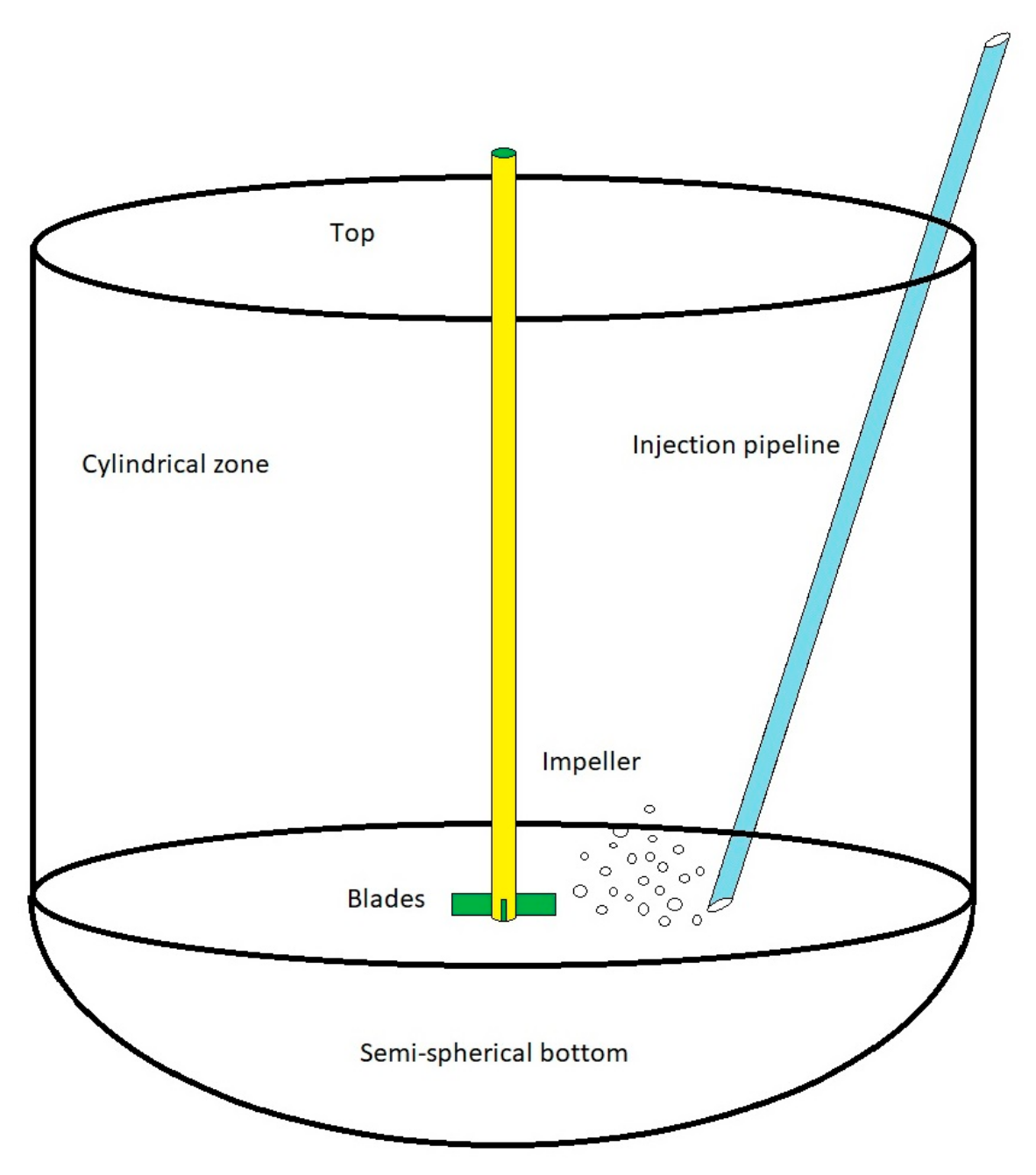
8. Conclusions
Funding
Institutional Review Board Statement
Data Availability Statement
Acknowledgments
Conflicts of Interest
References
- Zhang, W.; Yang, J.; Wu, X.; Hu, Y.; Yu, W.; Wang, J.; Dong, J.; Li, M.; Liang, S.; Hu, J.; et al. A critical review on secondary lead recycling technology and its prospect. Renew. Sustain. Energy Rev. 2016, 61, 108–122. [Google Scholar] [CrossRef]
- Li, Y.; Yang, S.; Taskinen, P.; He, J.; Liao, F.; Zhu, R.; Chen, Y.; Tang, C.; Wang, Y.; Jokilaakso, A. Novel recycling process for lead-acid battery paste without SO2 generation—Reaction mechanism and industrial pilot campaign. J. Clean. Prod. 2019, 217, 162–171. [Google Scholar] [CrossRef]
- Sun, Z.; Cao, H.; Zhang, X.; Lin, X.; Zheng, W.; Cao, G.; Sun, Y.; Zhang, Y. Spent lead-acid battery recycling in China—A review and sustainable analyses on mass flow of lead. Waste Manag. 2017, 64, 190–201. [Google Scholar] [CrossRef] [PubMed]
- Prengaman, R.; Mirza, A. 20—Recycling concepts for lead–acid batteries. In Lead-Acid Batteries for Future Automobiles; Elsevier: Amsterdam, The Netherlands, 2017; pp. 575–598. [Google Scholar] [CrossRef]
- Hildebrandt, T.; Osada, A.; Peng, S.; Moyer, T. 19—Standards and tests for lead–acid batteries in automotive applications. In Lead-Acid Batteries for Future Automobiles; Elsevier: Amsterdam, The Netherlands, 2017; pp. 551–573. [Google Scholar] [CrossRef]
- Moseley, P.; Rand, D.; Garche, J. 21—Lead–acid batteries for future automobiles: Status and prospect. In Lead-Acid Batteries for Future Automobiles; Elsevier: Amsterdam, The Netherlands, 2017; pp. 601–618. [Google Scholar] [CrossRef]
- Sloop, S.; Kotaich, K.; Ellis, T.; Clarke, R. RECYCLING|Lead–Acid Batteries: Electrochemical. In Encyclopedia of Electrochemical Power Sources; Elsevier: Amsterdam, The Netherlands, 2009; pp. 179–187. [Google Scholar] [CrossRef]
- Tian, X.; Gong, Y.; Wu, Y.; Agyeiwaa, A.; Zuo, T. Management of used lead acid battery in China: Secondary lead industry progress, policies and problems. Resour. Conserv. Recycl. 2014, 93, 75–84. [Google Scholar] [CrossRef]
- Blanpain, B.; Arnout, S.; Chintinne, M.; Swinbourne, D.R. Lead Recycling. In Handbook of Recycling; Elsevier: Amsterdam, The Netherlands, 2014; pp. 95–111. [Google Scholar] [CrossRef]
- Bailey, C.; Kumar, S.; Patel, M.; Piper, A.W.; Fosdick, R.A.; Hance, S. Comparison between CFD and measured data for the mixing of lead bullion. In Proceedings of the 2nd International Conference on CFD in Minerals and Process Industries CSIRO, Melbourne, Australia, 6–8 December 1999; pp. 351–356. [Google Scholar]
- Choi, B.S.; Wan, B.; Philyaw, S.; Dhanasekharan, K.; Ring, T.A. Residence Time Distributions in a Stirred Tank: Comparison of CFD Predictions with Experiment. Ind. Eng. Chem. Res. 2004, 43, 6548–6556. [Google Scholar] [CrossRef]
- Guha, D.; Ramachandran, P.; Dudukovic, M. Flow field of suspended solids in a stirred tank reactor by Lagrangian tracking. Chem. Eng. Sci. 2007, 62, 6143–6154. [Google Scholar] [CrossRef]
- Wang, F.; Mao, Z.-S.; Wang, Y.; Yang, C. Measurement of phase holdups in liquid–liquid–solid three-phase stirred tanks and CFD simulation. Chem. Eng. Sci. 2006, 61, 7535–7550. [Google Scholar] [CrossRef]
- Hartmann, H.; Derksen, J.; Akker, H.v.D. Numerical simulation of a dissolution process in a stirred tank reactor. Chem. Eng. Sci. 2006, 61, 3025–3032. [Google Scholar] [CrossRef]
- Huang, S.; Mohamad, A.; Nandakumar, K. Numerical Analysis of a Two-Phase Flow and Mixing Process in a Stirred Tank. Int. J. Chem. React. Eng. 2008, 6. [Google Scholar] [CrossRef]
- Koh, P.T.L.; Xantidis, F. CFD Modelling in the scale-up of a stirred reactor for resin beads. In Proceedings of the 2nd International Conference on CFD in Minerals and Process Industries CSIRO, Melbourne, Australia, 6–8 December 1999; pp. 369–374. [Google Scholar]
- Murthy, B.; Deshmukh, N.; Patwardhan, A.; Joshi, J. Hollow self-inducing impellers: Flow visualization and CFD simulation. Chem. Eng. Sci. 2007, 62, 3839–3848. [Google Scholar] [CrossRef]
- Zhang, Z.; Chen, G. Liquid mixing enhancement by chaotic perturbations in stirred tanks. Chaos Solitons Fractals 2008, 36, 144–149. [Google Scholar] [CrossRef]
- Colli, A.; Bisang, J. Evaluation of the hydrodynamic behaviour of turbulence promoters in parallel plate electrochemical reactors by means of the dispersion model. Electrochim. Acta 2011, 56, 7312–7318. [Google Scholar] [CrossRef]
- Zhao, H.-L.; Zhang, Z.-M.; Zhang, T.-A.; Liu, Y.; Gu, S.-Q.; Zhang, C. Experimental and CFD studies of solid–liquid slurry tank stirred with an improved Intermig impeller. Trans. Nonferrous Met. Soc. China 2014, 24, 2650–2659. [Google Scholar] [CrossRef]
- Gong, Y.; Tian, X.-M.; Wu, Y.-F.; Tan, Z.; Lv, L. Recent development of recycling lead from scrap CRTs: A technological review. Waste Manag. 2016, 57, 176–186. [Google Scholar] [CrossRef] [PubMed]
- Tamburini, A.; Cipollina, A.; Micale, G.; Brucato, A.; Ciofalo, M. Influence of drag and turbulence modelling on CFD predictions of solid liquid suspensions in stirred vessels. Chem. Eng. Res. Des. 2013, 92, 1045–1063. [Google Scholar] [CrossRef]
- Wadnerkar, D.; Tade, M.O.; Pareek, V.K.; Utikar, R.P. CFD simulation of solid–liquid stirred tanks for low to dense solid loading systems. Particuology 2016, 29, 16–33. [Google Scholar] [CrossRef]
- Karcz, J.; Cudak, M.; Szoplik, J. Stirring of a liquid in a stirred tank with an eccentrically located impeller. Chem. Eng. Sci. 2005, 60, 2369–2380. [Google Scholar] [CrossRef]
- Szalai, E.; Arratia, P.; Johnson, K.; Muzzio, F. Mixing analysis in a tank stirred with Ekato Intermig® impellers. Chem. Eng. Sci. 2004, 59, 3793–3805. [Google Scholar] [CrossRef]
- Pinho, F.; Piqueiro, F.; Proença, M.; Santos, A. Turbulent flow in stirred vessels agitated by a single, low-clearance hyperboloid impeller. Chem. Eng. Sci. 2000, 55, 3287–3303. [Google Scholar] [CrossRef]
- Vite-Martínez, P.; Durán-Valencia, C.; Cruz-Maya, J.; Ramírez-López, A.; López-Ramírez, S. Optimization of reagents injection in a stirred batch reactor by numerical simulation. Comput. Chem. Eng. 2014, 60, 307–314. [Google Scholar] [CrossRef]
- Pan, H.; Geng, Y.; Dong, H.; Ali, M.; Xiao, S. Sustainability evaluation of secondary lead production from spent lead acid batteries recycling. Resour. Conserv. Recycl. 2018, 140, 13–22. [Google Scholar] [CrossRef]
- Escudié, R.; Liné, A. Analysis of turbulence anisotropy in a mixing tank. Chem. Eng. Sci. 2006, 61, 2771–2779. [Google Scholar] [CrossRef]
- Vite-Martinez, P.; Ramirez-Lopez, A.; Romero-Serrano, A.; Chavez-Alcala, F. Improving of Mixing Efficiency in a Stirred Reactor for Lead Recycling Using Computer Simulation. Inz. Miner. 2014, 16, 25–32. [Google Scholar]
- Wadnerkar, D.; Utikar, R.P.; Tade, M.O.; Pareek, V.K. CFD simulation of solid–liquid stirred tanks. Adv. Powder Technol. 2012, 23, 445–453. [Google Scholar] [CrossRef]
- Xie, L.; Luo, Z.-H. Modeling and simulation of the influences of particle-particle interactions on dense solid–liquid suspensions in stirred vessels. Chem. Eng. Sci. 2018, 176, 439–453. [Google Scholar] [CrossRef]
- Gu, D.; Liu, Z.; Xie, Z.; Li, J.; Tao, C.; Wang, Y. Numerical simulation of solid-liquid suspension in a stirred tank with a dual punched rigid-flexible impeller. Adv. Powder Technol. 2017, 28, 2723–2734. [Google Scholar] [CrossRef]
- Jauhiainen, A.; Jonsson, L.; Sheng, D.-Y. Modelling of alloy mixing into steel. The influence of porous plug placement in the ladle bottom on the mixing of alloys into steel in a gas-stirred ladle. A comparison made by numerical simulation. Scand. J. Metall. 2001, 30, 242–253. [Google Scholar] [CrossRef]
- Chen, C.; Jonsson, L.T.I.; Tilliander, A.; Cheng, G.; Jönsson, P.G. A Mathematical Modeling Study of Tracer Mixing in a Continuous Casting Tundish. Metall. Mater. Trans. A 2014, 46, 169–190. [Google Scholar] [CrossRef]
- Zhang, Y.; Chen, C.; Lin, W.; Yu, Y.; Dianyu, E.; Wang, S. Numerical Simulation of Tracers Transport Process in Water Model of a Vacuum Refining Unit: Single Snorkel Refining Furnace. Steel Res. Int. 2020, 91, 2000022. [Google Scholar] [CrossRef]
- Ouyang, X.; Lin, W.; Luo, Y.; Zhang, Y.; Fan, J.; Chen, C.; Cheng, G. Effect of Salt Tracer Dosages on the Mixing Process in the Water Model of a Single Snorkel Refining Furnace. Metals 2022, 12, 1948. [Google Scholar] [CrossRef]
- Morales, R.D.; Calderon-Hurtado, F.A.; Chattopadhyay, K. Demystifying Underlying Fluid Mechanics of Gas Stirred Ladle Systems with Top Slag Layer Using Physical Modeling and Mathematical Modeling. ISIJ Int. 2019, 59, 1224–1233. [Google Scholar] [CrossRef]
- Rahimi, M.; Parvareh, A. CFD study on mixing by coupled jet-impeller mixers in a large crude oil storage tank. Comput. Chem. Eng. 2007, 31, 737–744. [Google Scholar] [CrossRef]
- Sossa-Echeverria, J.; Taghipour, F. Computational simulation of mixing flow of shear thinning non-Newtonian fluids with various impellers in a stirred tank. Chem. Eng. Process.—Process. Intensif. 2015, 93, 66–78. [Google Scholar] [CrossRef]
- Lassin, A.; Piantone, P.; Burnol, A.; Bodénan, F.; Chateau, L.; Lerouge, C.; Crouzet, C.; Guyonnet, D.; Bailly, L. Reactivity of waste generated during lead recycling: An integrated study. J. Hazard. Mater. 2007, 139, 430–437. [Google Scholar] [CrossRef]
- Weidenhamer, J.D.; Clement, M.L. Evidence of recycling of lead battery waste into highly leaded jewelry. Chemosphere 2007, 69, 1670–1672. [Google Scholar] [CrossRef]
- Milewska, A.; Molga, E. CFD simulation of accidents in industrial batch stirred tank reactors. Chem. Eng. Sci. 2007, 62, 4920–4925. [Google Scholar] [CrossRef]






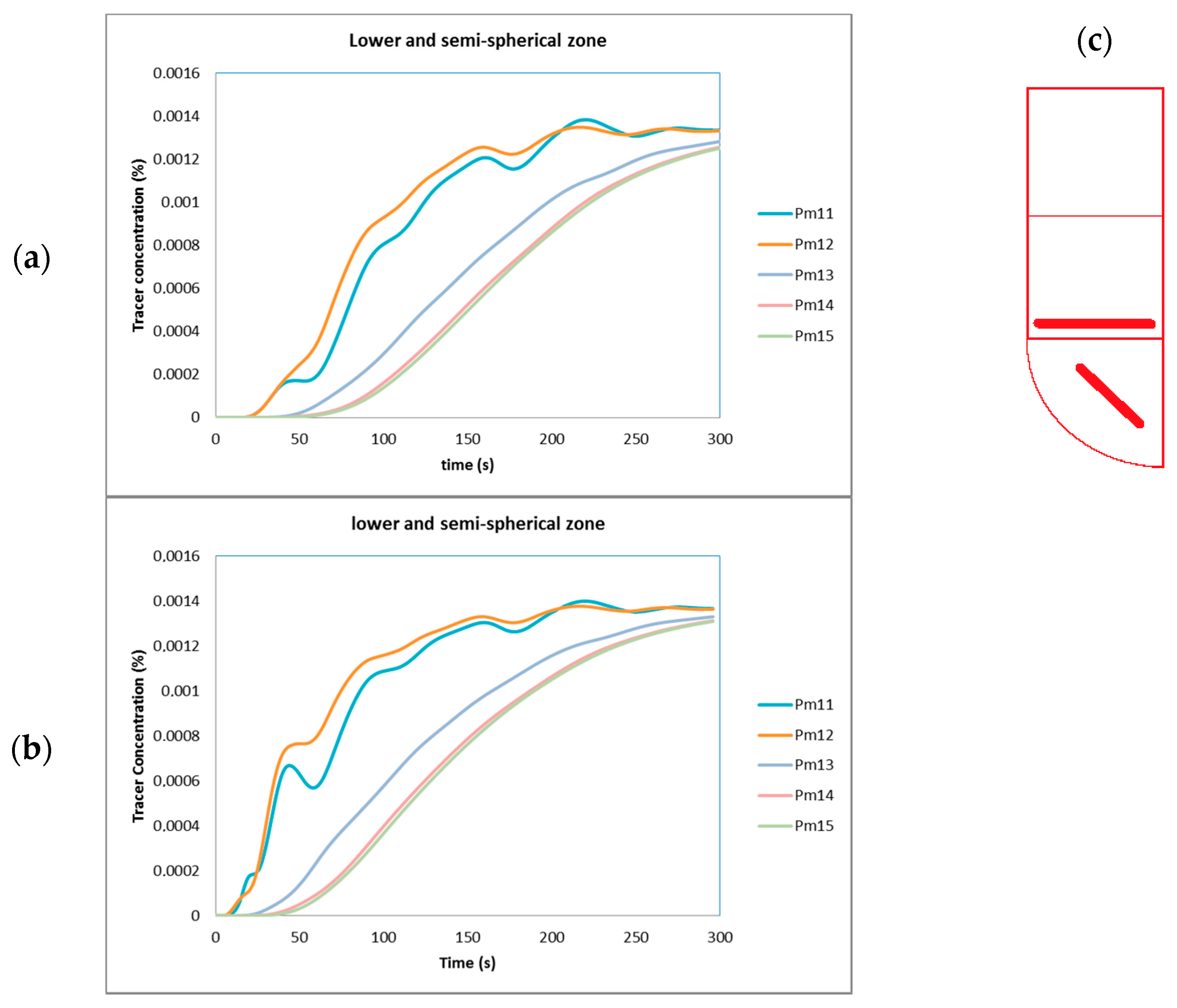

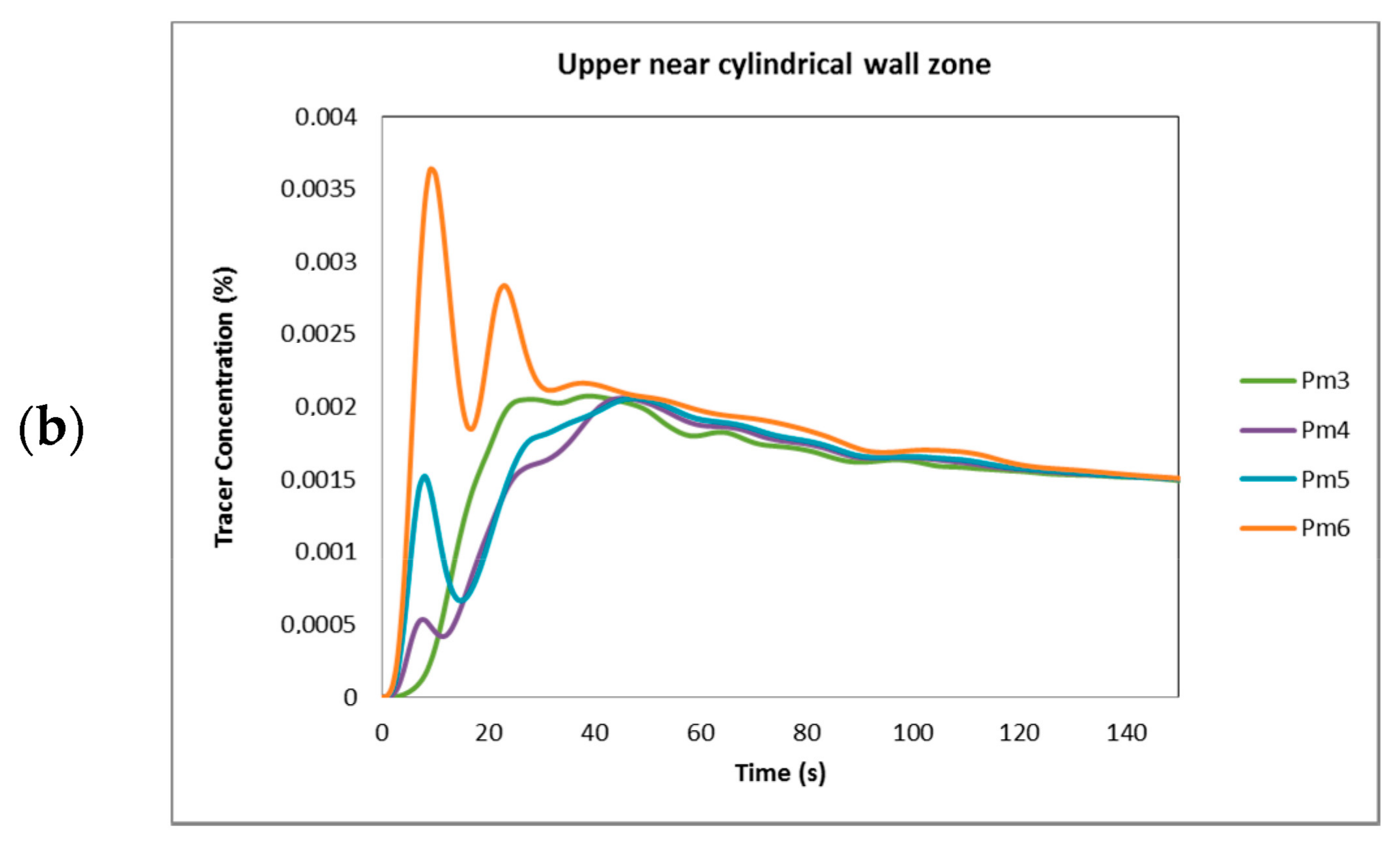

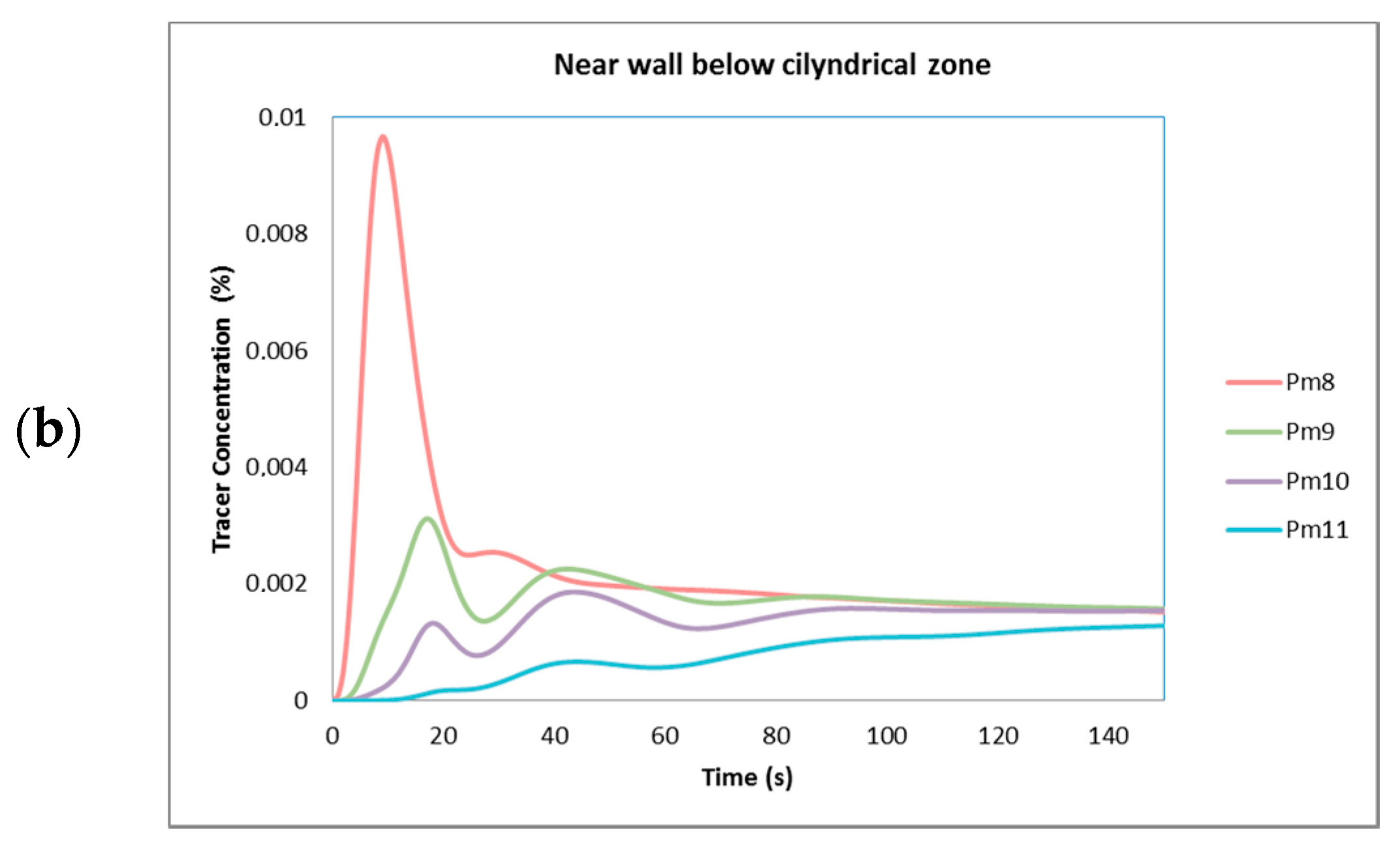
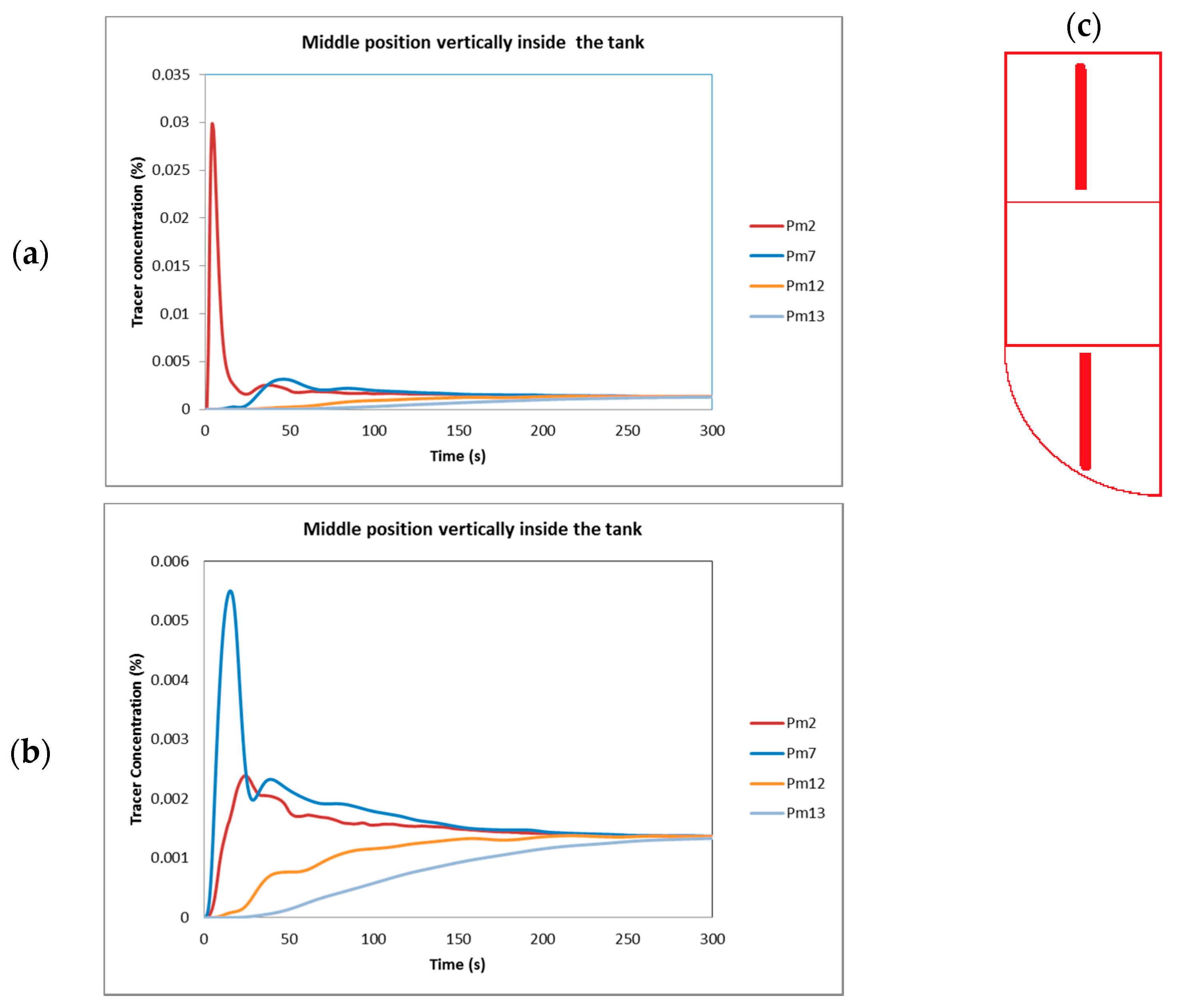
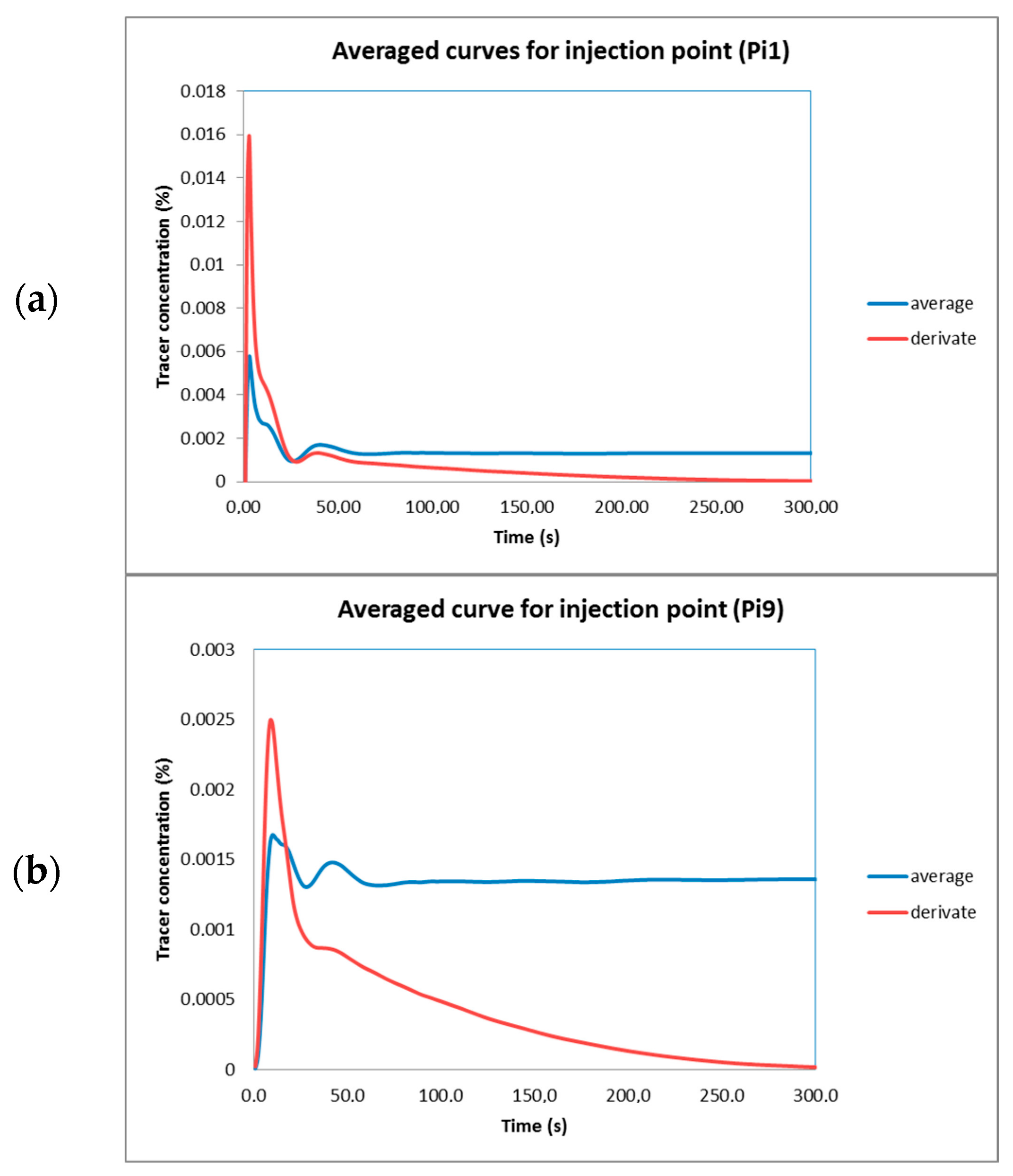
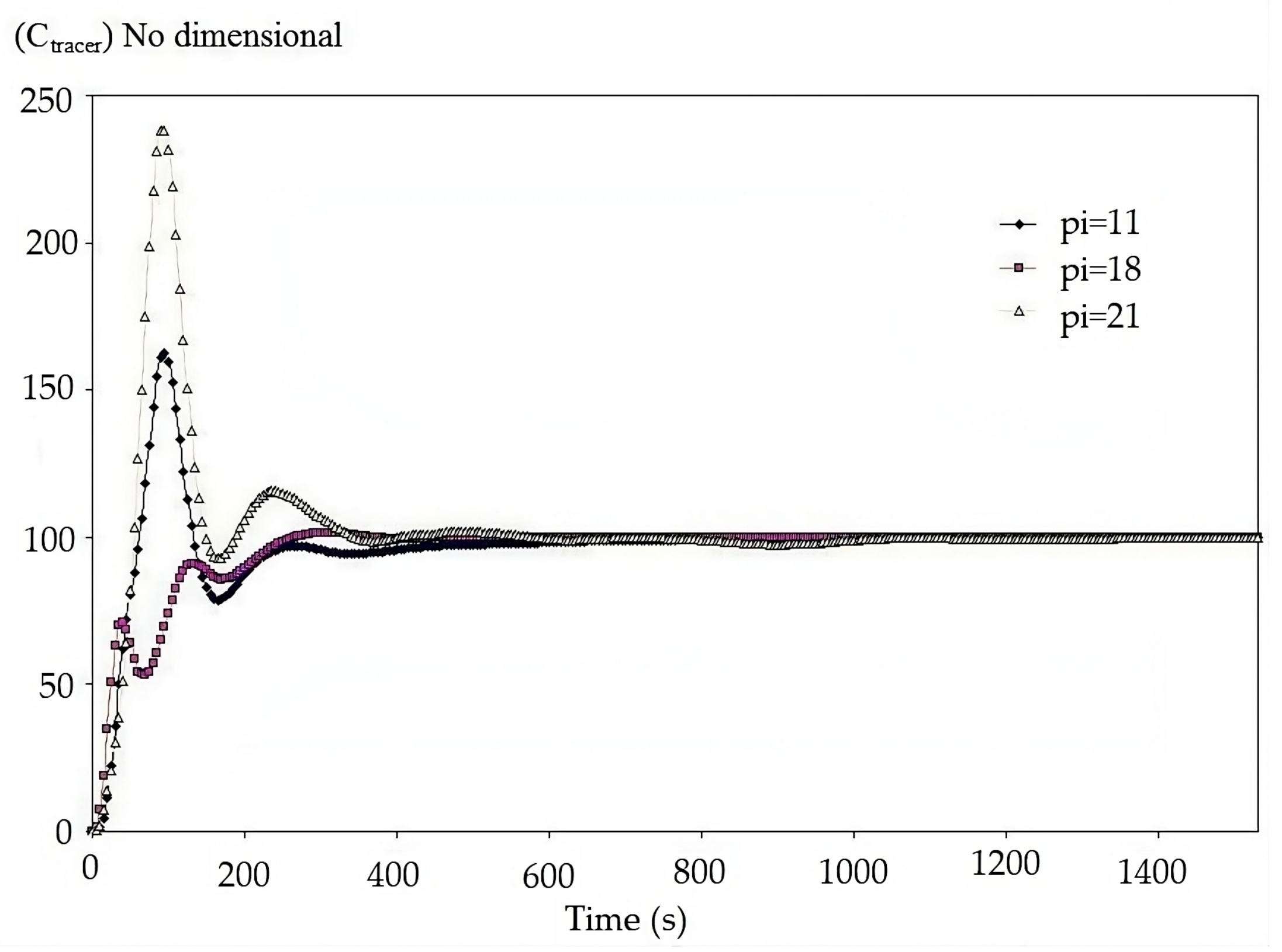
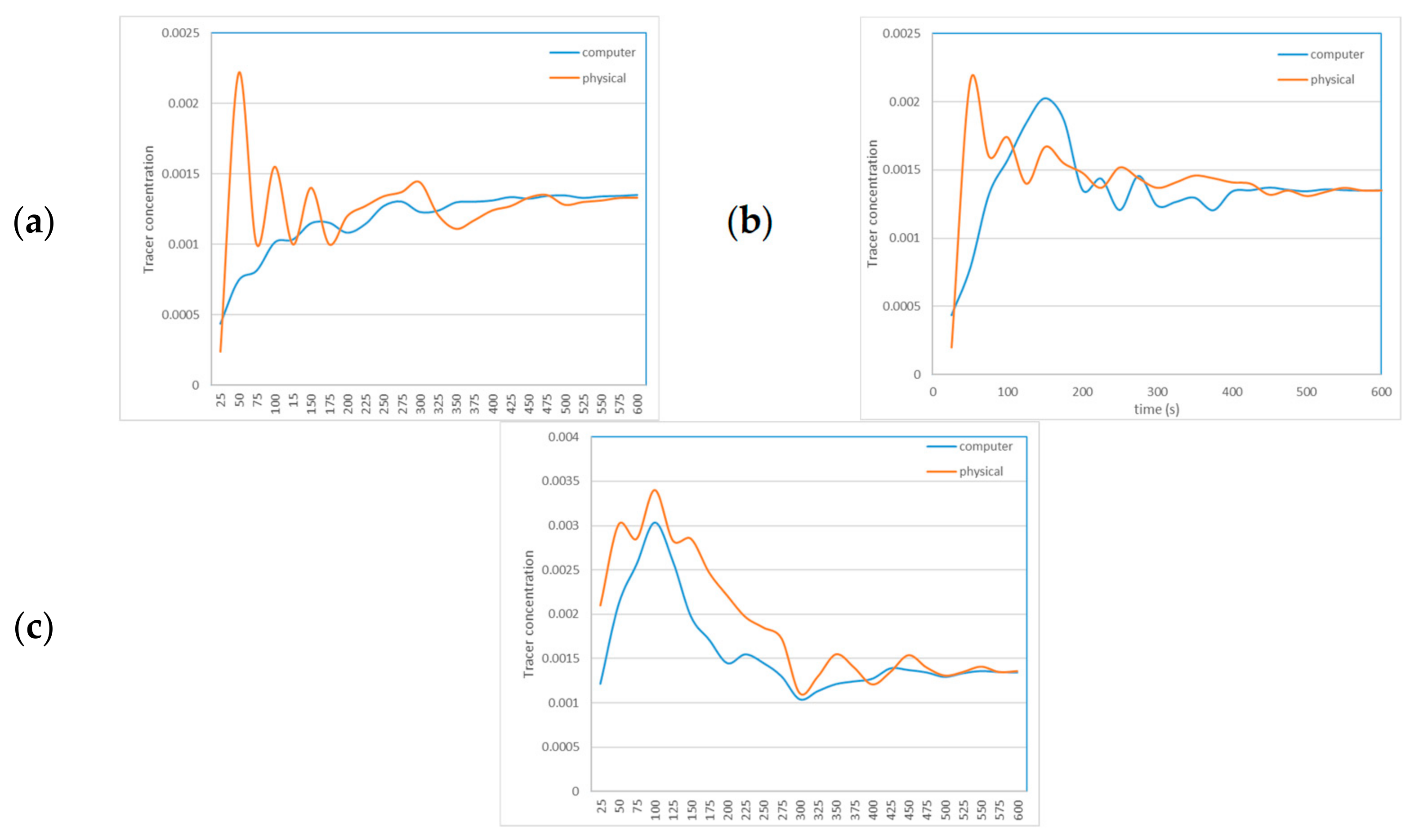

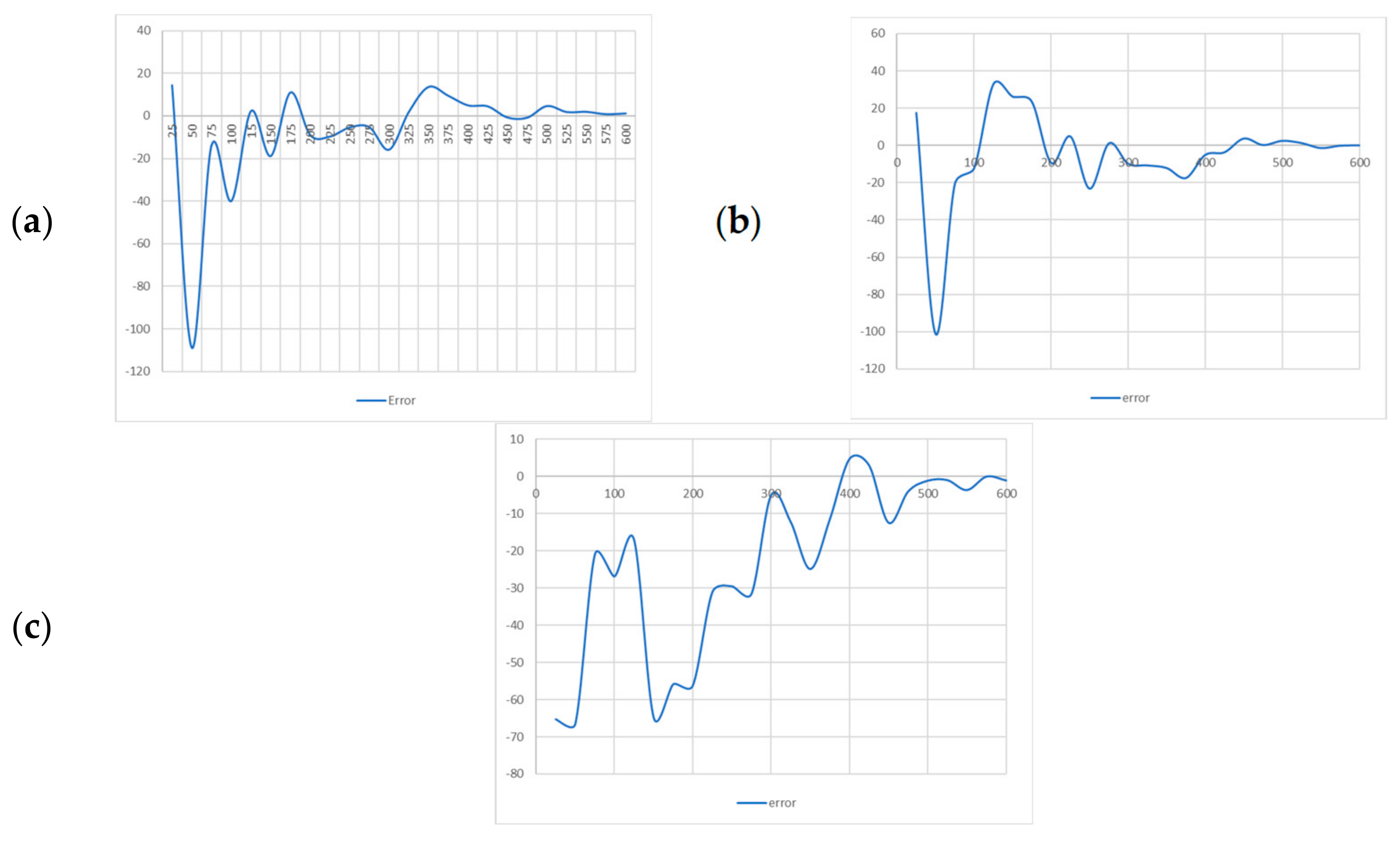
Disclaimer/Publisher’s Note: The statements, opinions and data contained in all publications are solely those of the individual author(s) and contributor(s) and not of MDPI and/or the editor(s). MDPI and/or the editor(s) disclaim responsibility for any injury to people or property resulting from any ideas, methods, instructions or products referred to in the content. |
© 2023 by the author. Licensee MDPI, Basel, Switzerland. This article is an open access article distributed under the terms and conditions of the Creative Commons Attribution (CC BY) license (https://creativecommons.org/licenses/by/4.0/).
Share and Cite
Ramirez-Lopez, A. Analysis of the Hydrodynamics Behavior Inside a Stirred Reactor for Lead Recycling. Fluids 2023, 8, 268. https://doi.org/10.3390/fluids8100268
Ramirez-Lopez A. Analysis of the Hydrodynamics Behavior Inside a Stirred Reactor for Lead Recycling. Fluids. 2023; 8(10):268. https://doi.org/10.3390/fluids8100268
Chicago/Turabian StyleRamirez-Lopez, Adan. 2023. "Analysis of the Hydrodynamics Behavior Inside a Stirred Reactor for Lead Recycling" Fluids 8, no. 10: 268. https://doi.org/10.3390/fluids8100268




